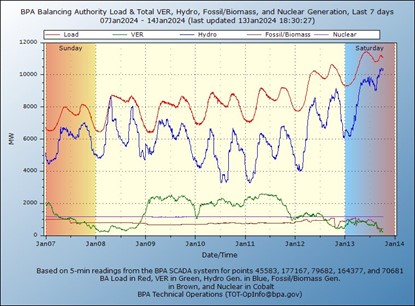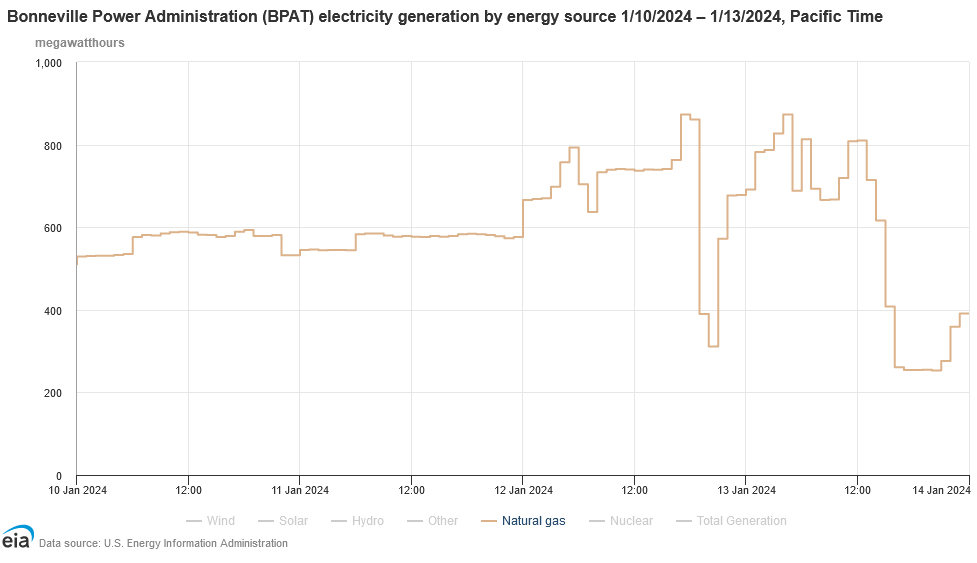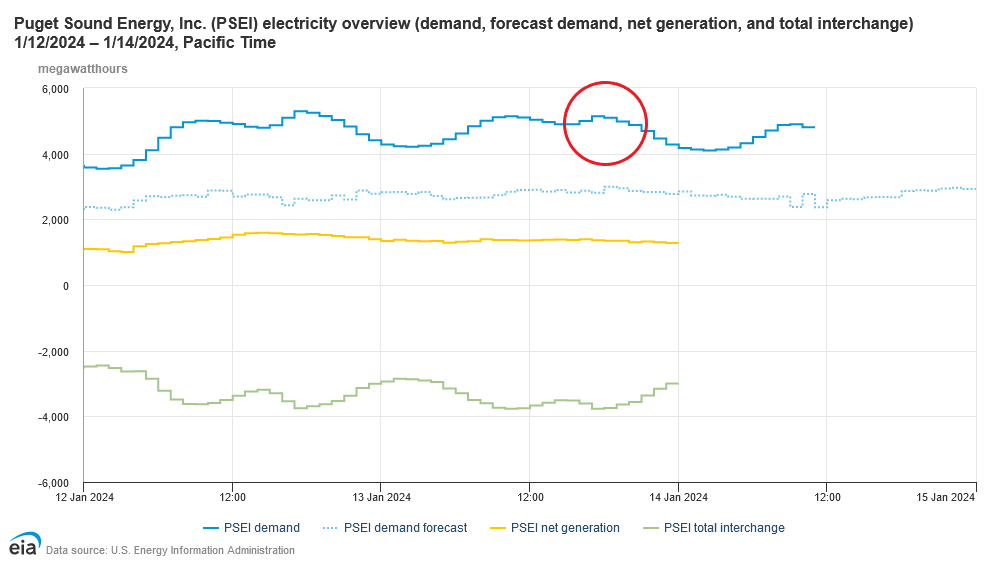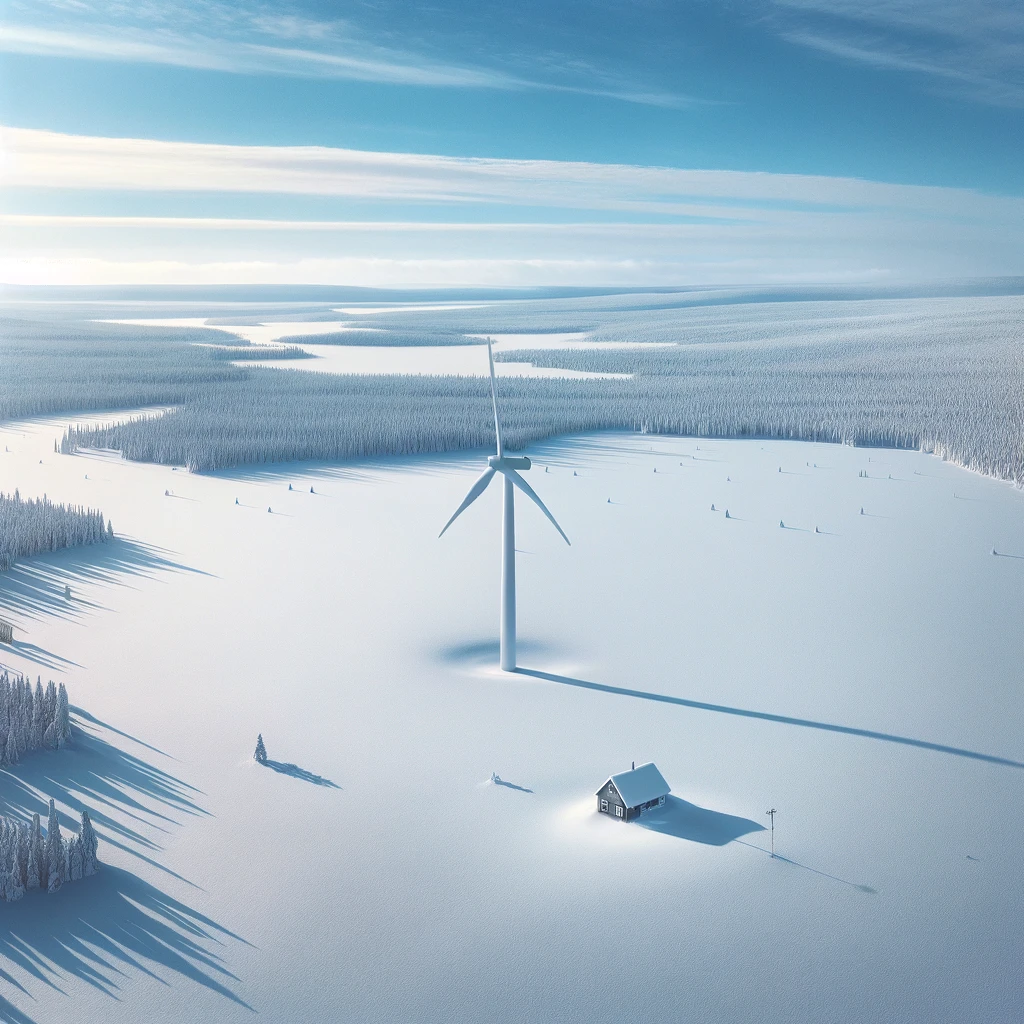What happens when cold temperatures move across the Northwest, there is less natural gas power available, and wind disappears? We found out on Saturday, as Puget Sound Energy (PSE) had to ask customers to conserve to keep the grid stable. It is a case study of the need to ensure Washington has energy sources that can be turned on when needed, and of the need to empower consumers by making energy prices transparent.
As temperatures plummeted across Washington state on January 13, PSE sent a notice to customers asking them to reduce their use of electricity and natural gas. The notice said, “Due to the extreme cold temperatures facing our area, regional utilities are experiencing higher energy use than forecasted, and we need to reduce strain on the grid.”
 As demand from customers across the Northwest increased (the red line on the chart), wind-generated electricity, listed as “VER” on the chart, fell significantly. Data from the Bonneville Power Administration (BPA) shows that demand increased significantly during Friday and peaked on Saturday. Hydro power made up the difference, increasing from about 6,800 megawatt hours (MWh) at its peak on Thursday to over 10,300 MWh on Saturday night – an increase of 52 percent.
As demand from customers across the Northwest increased (the red line on the chart), wind-generated electricity, listed as “VER” on the chart, fell significantly. Data from the Bonneville Power Administration (BPA) shows that demand increased significantly during Friday and peaked on Saturday. Hydro power made up the difference, increasing from about 6,800 megawatt hours (MWh) at its peak on Thursday to over 10,300 MWh on Saturday night – an increase of 52 percent.
Between 9 am and 9 pm on Saturday, wind-generated electricity fell from 876 MWh to 129 MWh. Just two days earlier, wind turbines were creating more than 2,500 MWh across the BPA system. As the cold front moved in on late Thursday along with the cold temperatures, wind power disappeared.
Compounding those factors was the failure of a natural gas line. A spokesman for PSE said the Jackson Prairie natural gas distribution facility went down Saturday afternoon but was operational later that evening. They said the cause was failure of “redundant fiber optic cables.” The facility provides natural gas used for electricity generation and heating.
 There is some evidence that the shutdown of the line had an impact on electricity generated by natural gas. At noon on Saturday, natural gas was generating 808 MWh. Five hours later, that had fallen to 261 MWh.
There is some evidence that the shutdown of the line had an impact on electricity generated by natural gas. At noon on Saturday, natural gas was generating 808 MWh. Five hours later, that had fallen to 261 MWh.
To deal with the shortages, PSE sent a notice to customers asking them to conserve where possible. Utilities are increasingly engaging customers to help deal with energy shortages. In 2022, California sent a text to residential electricity customers asking them to conserve. It was effective and the near-immediate reduction in electricity demand may have avoided blackouts.
 Puget Sound Energy claims they saw a reduction in electricity use after the notifications, but data from Saturday (in the red circle) show the impact was modest.
Puget Sound Energy claims they saw a reduction in electricity use after the notifications, but data from Saturday (in the red circle) show the impact was modest.
The peak on Saturday was similar to the morning and lower than on Friday night, but the data don’t show an unusual decline after PSE sent the notices.
There are a few lessons from the event.
Many people will focus on the decline in wind power precisely at the moment when demand increased due to cold temperatures. This is a common problem across the Northwest – wind disappears when there are extremely high or low temperatures. Increasing the percentage of electricity generated by wind and solar increases the risk that there will be future shortages when electricity demand increases due to weather or increased overall demand from more heat pumps and electric vehicles.
We should also focus on the increased demand. It is not surprising that as temperatures dropped, demand increased significantly as people turned on their heaters. People were reluctant to turn down their thermostat in response to PSE’s request, especially when there is no apparent financial incentive. Providing a financial incentive – such as a rebate or a clear reduction in rates – would encourage people to find ways to save electricity, even if that meant waiting to dry clothes, wash dishes, or unplug an electric vehicle.
I have heard skepticism about using price signals to get people to conserve. Some argue that government and utilities should just build more reliable sources of energy in the same way people could have generators installed as an insurance policy against brownouts.
I agree that we must continue to have a significant percentage of electricity provided by predictable sources. But customers will always end up paying higher rates for electricity when demand is high. Building generation capacity – on the grid or a generator at your home – increases costs, especially if it is used only during extreme weather events. The day-ahead prices paid by utilities on the market more than doubled from Friday to Saturday as demand continued to rise.
It may be less expensive for consumers to conserve during those rare occasions when prices are unusually high than to have generating capacity on standby for these situations. By providing clear financial incentives, utilities can avoid having to build excess generating capacity that is used infrequently.
Puget Sound Energy and other utilities have programs that reward customers for adjusting their thermostats when there is a shortage of electricity. Increasing the use of these programs would engage customers to keep the grid stable and avoid having to pay high prices.
Despite the convergence of several factors, Washington residents didn’t face blackouts. However, the event offers a good lesson about the risks faced by intermittent sources of electricity and the need to use price signals and financial incentives to engage consumers.



